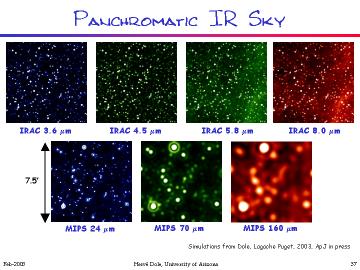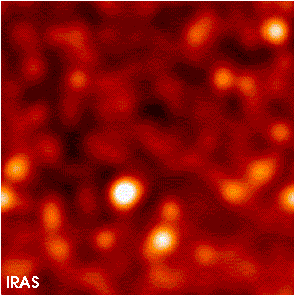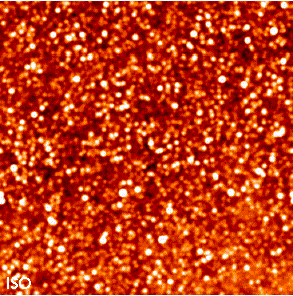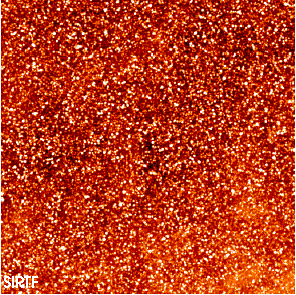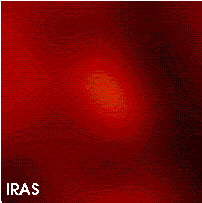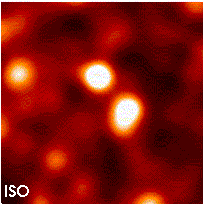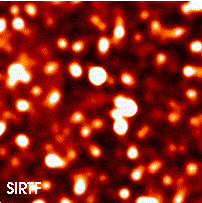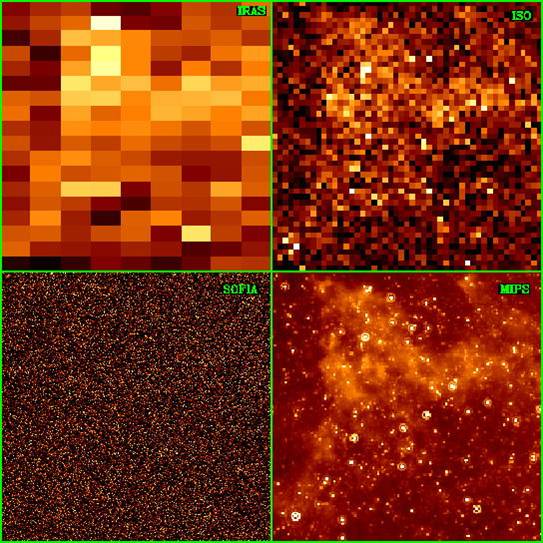Difference between revisions of "Confusion"
m |
m |
||
| Line 55: | Line 55: | ||
{| border="1" | {| border="1" | ||
| − | |[[image:irbknd. | + | |[[image:irbknd.jpg]] |
| Additional views of the 160 micron simulated sky, observed at different resolutions. Left to right, they are DIRBE (45 arcminute pixels), ISO (90 arcsecond pixels), and MIPS (45 arcsecond pixels). | | Additional views of the 160 micron simulated sky, observed at different resolutions. Left to right, they are DIRBE (45 arcminute pixels), ISO (90 arcsecond pixels), and MIPS (45 arcsecond pixels). | ||
| + | |} | ||
| + | |||
| + | |||
| + | {| border="1" | ||
| + | |[[image:comparison70sky.jpg]] | ||
| + | | Additional views of the 70 micron simulated sky, 1-hour exposure, observed at different resolutions with different instruments. Note that the simulated SOFIA exposure is dominated by background noise from the (warm) telescope. | ||
|} | |} | ||
Latest revision as of 20:34, 22 January 2010
Introduction
The term "confusion-limited" refers to images in which there are so many detected sources that distinguishing individual objects is difficult. In a confusion-limited image, the spatial structure of the background resembles the superposition of many point sources. In the optical, the confusion limit is not often encountered, but can be reached in dense star clusters (e.g., in the image shown below). At near-infrared wavelengths, the background is usually dominated by emission from partially-resolved and unresolved stars or distant galaxies. In the mid- and far-IR, the background can also contain a contribution from Galactic "cirrus" emission. In an image that is near or at the confusion limit, determining whether a particular faint source is part of the background or is a target can be difficult.
The structure of the background effectively increases its noise contribution above what would be calculated based on the flux contributed by all of the sources in a region. The structure contributes directly to the variance of the background as it would be measured by aperture or PSF-fitting photometry extraction software, for example.
The kinds of confusion observers need to worry about depends on the science goals of the observation. The confusion noise will be different if one wants to extract photometry of sources in an unbiased survey, rather than measuring a source that is known to exist at shorter wavelengths. For example, when the observer has a priori knowledge of a source position, in some cases it may be possible to integrate somewhat below the confusion limit to obtain photometry of that object. The presence of a nearby bright source, with its associated diffraction artifacts, will raise the effective confusion limit. Moving targets offer the possibility of making a second, so-called "shadow" observation, which allows the suppression of confusing sources by subtracting them away.
The degree of confusion depends on the wavelength of the observation because of optical properties (PSF, etc) and also galaxy density and their spectral energy distributions (SEDs), the Galactic cirrus SED and structure, etc. This is not an "easy" computation, which is why firm confusion predictions for Spitzer are so difficult; see below.
By studying the fluctuations (variations in brightness) from one patch of sky to the next, we may be able to learn more about the most distant galaxies (or stars). Power spectrum analysis (meaning studying mathematically how the brightness varies with size of the patch on the sky) can be used to quantify the fluctuations.
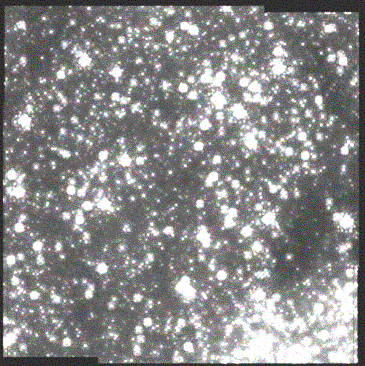 This image is an example of a confused field from NICMOS observations near the Galactic Center.
This image is an example of a confused field from NICMOS observations near the Galactic Center.
Confusion and Spitzer
Because of Spitzer's high sensitivity and relatively large diffraction-limited image size at the longer wavelengths, many Spitzer images are confusion-noise-limited. This means that there is no truly empty or dark places in a Spitzer image, with light from distant galaxies (or stars) on every pixel.
Because Spitzer provides much smaller effective beams and higher sensitivity than any previous mission, determining the confusion limit set by such sources is difficult. There is considerable uncertainty as to the nature of the background galaxy counts, and a series of activities in the early mission have given preliminary confusion and source count results for MIPS. Most formal definitions of confusion place the confusion noise at microJy levels and below for IRAC wavelengths, and at mJy levels for MIPS wavelengths. However, users should be aware that even at the many microJy level (corresponding to equivalent K-band mangitudes of 19-20), the density of galaxies may still approach several per square arcminute. This may cause problems for some science programs.
IRAC photometry at the shortest wavelengths can be confusion-limited due to either galaxy or star density. For MIPS, the accuracy of photometry at 70 and 160 µm will often be confusion-limited, as MIPS will detect not only background galaxies, but Galactic cirrus structure. Observers should use the available tools to investigate IR background levels in general. For issues specifically relevant to confusion levels, observers should (a) specifically consider using 2MASS images to investigate stellar density if relevant; and/or (b) take into account the existence of extragalactic background sources, particularly in the very sensitive 3.6 micron IRAC channel where galaxies still emit strongly; and/or (c) use IRAS images to investigate the Galactic cirrus structure.
Here are some references on confusion limits and Spitzer:
- Jeong, W-S., et al., Far-infrared detection limits - I. Sky confusion due to Galactic cirrus, 2005, MNRAS, 357, 535
- Kiss, Cs., Klaas, U., and Lemke, D., Determination of Confusion Noise for Far-Infrared Measurements, 2005, A&A, 430, 343
- Marleau et al, Extragalactic Source Counts at 24 Microns in the Spitzer First Look Survey, 2004, ApJS, 154, 66
- Papovich et al, The 24 Micron Source Counts in Deep Spitzer Space Telescope Surveys, 2004, ApJS, 154, 70
- Dole et al, Far-infrared Source Counts at 70 and 160 Microns in Spitzer Deep Surveys, 2004, ApJS, 154, 87
- Dole et al, Confusion of Extragalactic Sources in the Mid- and Far-Infrared: Spitzer and Beyond, 2004, ApJS, 154, 93
- Dole, Confusion and Extragalactic Surveys, a talk given in August 2003.
- Dole, website on Spitzer simulations, 2003
- Dole et al., "Predictions for Cosmological Infrared Surveys from Space with the Multiband Imaging Photometer for SIRTF," 2003, ApJ, 585, 617
- Franceschini et al., "The SWIRE SIRTF Legacy Program: Studying the Evolutionary Mass Function and Clustering of Galaxies," 2002, conference proceedings, available at astro-ph/0202463
- Friedmann and Bouchet, "Fluctuation analysis of the far-infrared background - information from the confusion," 2004, MNRAS, 348, 737
- Vaisanen et al., "Confusion limit resulting from galaxies: using the Infrared Array Camera on board SIRTF," 2001, MNRAS, 325, 1241
- Xu et al., "Models for Multiband Infrared Surveys," 2001, ApJ, 562, 179
Another oft-cited paper is the following by Helou and Beichman, "The Confusion Limits to the Sensitivity of Submillimeter Telescopes," 1990, In ESA, "From Ground-Based to Space-Borne Sub-mm Astronomy", p 117-123.
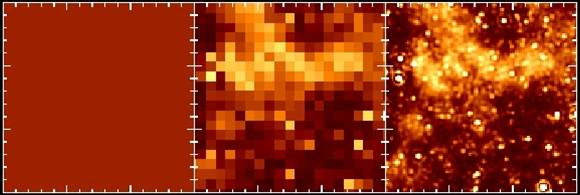
|
Additional views of the 160 micron simulated sky, observed at different resolutions. Left to right, they are DIRBE (45 arcminute pixels), ISO (90 arcsecond pixels), and MIPS (45 arcsecond pixels). |
